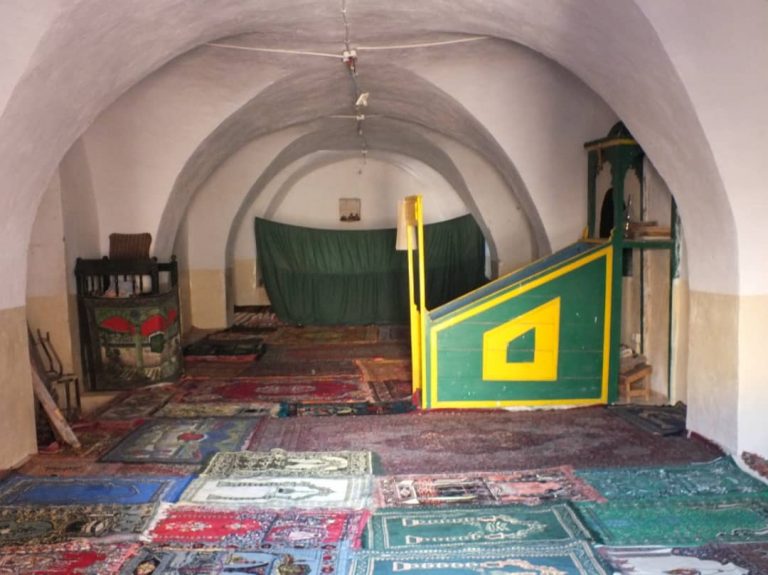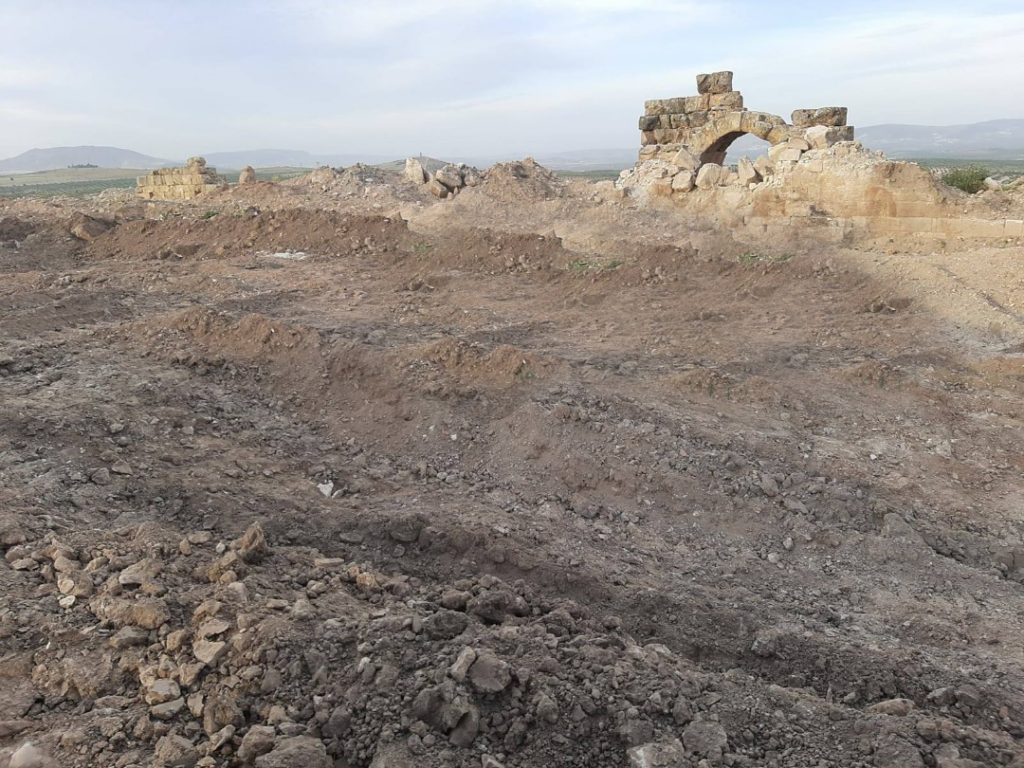AFRIN, Syria (North Press) – Renovation works that Turkey has carried out at the Nebi Huri archeological site in Afrin, northwest Syria, aim to cover up illegal excavations carried out by Turkish authorities, according to Salah Sino, co-chair of the directorate of Antiquities in Afrin that is currently operating in the northern countryside of Aleppo.
In mid-2020, following other renovations to parts of the Nebi Huri archeological site, the Directorate of Endowments of the Turkish state of Hatay announced renovation work of the site.
The site, which is located to the northeast of Afrin, 45 kilometers from the city center, includes a roman pyramidal graveyard dating back to the middle of the third century AD, as well as a khan (traveler’s inn) and a mosque dating back, as written on the gate of the mosque, to 1859 AD (during the Ottoman period), and it is surrounded by a wall and includes a well.
Cyrus/Korush city, 650 meters from the roman graveyard, is an ancient city which witnessed several ancient civilizations including Greeks, Romans, Byzantines, and Islamic caliphates.
After Turkey took control of the region in March of 2018, it began paving the courtyard between the mosque and the khan, and in late 2019, it demolished the mosque’s balcony, removed the tiles, carried out broad-scale excavations in the courtyard, and uprooted trees there.
In mid-2020, Turkey carried out other renovations in the mosque, wall, and khan, where they paved the yard again and added other new elements in the mosque including a wooden balcony, and they replaced the old pulpit with another Ottoman-featured one.

Additionally, they established reception halls outside the wall and renovated the Roman graveyard, and photos published on social media showed scaffolds for construction and restoration.
Hiding excavations
All these works were carried out in order to hide excavations that occurred in the site which were done to search for ancient artifacts, according to Sino.
Moreover, Turkey put signs written in Turkish with Arabic translations on each room in the graveyard and they raised both the Turkish flag and flag of the Syrian opposition over the archaeological site.
Meanwhile, video footages which North Press obtained showed a sign in the graveyard on which was written “T.C.Vakıflar Genel Müdürlüğü” (Directorate General of Religious Endowments) which is a Turkish governmental institution that manages and audits waqfs (an inalienable charitable endowments under Islamic law) dating back to the Ottoman Empire which still exists today.
Between the 1950s and 1960s, the directorate confiscated and managed real estate assets and many properties acquired by the minority foundations according to questionable court decisions. A notable example of this is the 1984 confiscation of the Tuzla camp for Armenian children.
Sino believes that Turkey manipulated the site in order to show it as dating back to the Ottoman era, since the Roman tomb is rich in Roman decorations and inscriptions, both the mosque and the khan are shown as simple and modern compared to the tomb.
During the past years, the city of Cyrus witnessed excavations and bulldozing work over an area of more than 60 acres, according to the co-chair of the Directorate of Antiquities in Afrin.

“How they can demolish ruins of these civilizations with the aim of highlighting one part of them, which is the Ottoman mosque that Turkish companies renovated and presented to be a pivotal building for the site?” Sino wondered.
Nebi Huri is home to the only Ottoman-era mosque in Afrin, “while Turkey works hard to destroy all other ancient civilizations and strengthen this building,” he stressed.
Afrin contains 56 archeological sites registered in Syrian government directorates, in addition to more than 40 archeological sites that were documented by the Directorate of Antiques of Autonomous Administration of North and East Syria (AANES) in Afrin region between 2014 and 2018.
Strengthening Turkish presence
Renovations carried out by Turkey violate the scientific principles set for restoration of archaeological buildings, since “it is trying to show itself as interested in cultural heritage and antiquities, in addition to strengthening Turkish presence in the region,” Sino indicated.
Video footage clearly shows the changes to the historical character of the site and its replacement with Ottoman features.
Before the Turkish occupation of the region, residents of Afrin used to visit Nebi Huri shrine and attach stones to a wall near the mosque, believing that this would grant their wishes. In the graveyard, pomegranate tree branches used to be filled with colorful fabric stripes that visitors used to tied up in order to make their wishes come true.
Turkish forces in the Turkish-occupied areas in Afrin and its villages have Turkified the names of parks, schools, and squares, such as the Ottoman Nation Park in Azaz, Recep Tayyip Erdogan Square, and the Bulant al-Bayrek School in Bab.
Turkey is strengthening its policy of Turkification with the aim of imposing a Turkish character on civil and cultural departments, according to residents living in areas held by Turkey and Turkish-backed armed Syrian factions in Syria’s north.
Those people fear that the Turkification will be a project to annex those areas to Turkey, contradicting official Turkish statements regarding the unity and safety of Syrian lands.
In July 2019, the General Directorate of Antiquities and Museums in Syria called on international organizations, international legal and academic figures interested in culture, and all those interested in human civilization to intervene in order to protect Syria’s cultural heritage, and put an end to what it had described as the unjust aggression of the Turkish military on the archaeological sites in the Aleppo countryside.
The government statement at the time said that photos from Afrin showed the discovery of rare statues and sculptures dating back to the first millennium BC and the Roman era.
These violations are carried out in most of the archaeological sites of Afrin registered on the National Heritage List including Tel Berij Abdalo, Tel Ein Dara, Tel Jendiris, and Nebi Huri site, according to the statement.
The Directorate of Antiques in Afrin documented phases of renovation carried out on the sites and participated in them with UN institutions and international, regional and local media, according to the Directorate.

